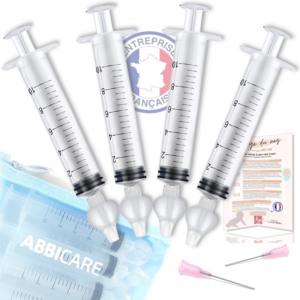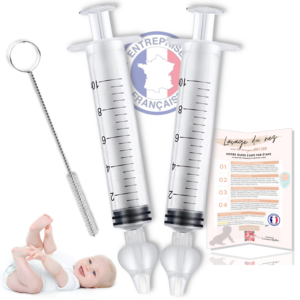
Everything you need to know about making the most of your ABBICARE™ non-contact thermometer.
You have just purchased our ABBICARE™ infrared thermometer, and we sincerely thank you.
It’s important for us to clearly present the benefits of our thermometer while also acknowledging its limitations, which are not specific to our model but common to all non-contact infrared thermometers.
The ABBICARE™ thermometer provides a fast, efficient, and contactless alternative to traditional thermometers. While it offers undeniable advantages, we want to highlight both its strengths and its limitations in this presentation.
We recommend that you to carefully read (or reread) our user manual, available in a digital, zoomable version >HERE<.

➡️ How to Position the Thermometer in Its Case?

We recommend placing the thermometer slightly on its side before closing the case to prevent it from turning on accidentally (see example in the image).
➡️ Understanding the Different Methods of Measuring Body Temperature
Body temperature readings may vary by a few tenths of a degree depending on the measurement method (rectal, oral, temporal, etc.).
In Europe, rectal temperature is traditionally used as a reference because it is the closest to core body temperature.
- Rectal Measurement
Rectal temperature measurement is the most commonly used method in Europe. It is very accurate but can be inconvenient and less hygienic. Additionally, changes in body temperature become visible only 30 to 45 minutes later with this method. It is mainly used for infants and young children but can be difficult depending on the child’s mood or when they are asleep.
- Oral Measurement
Oral temperature is usually 0.6°C to 1°C lower than rectal temperature. This method is less reliable as it can be affected by breathing, drinking hot or cold beverages, or incorrect positioning. Temperature variations of up to 1°C can occur between measurements.
- Axillary (Underarm) Measurement
Axillary temperature is 0.5°C to 1°C lower than rectal temperature. This method is the slowest and can be influenced by anatomical factors such as low body fat or, conversely, excessive fat in the underarm area.
- Tympanic (Ear) Measurement
Tympanic temperature is 0°C to 0.5°C lower than rectal temperature. The measurement is taken by inserting the sensor into the ear canal. It is important to ensure proper positioning and cleanliness of the sensor, as a narrow ear canal or earwax buildup can affect accuracy. This method is not recommended for children under 2 years old due to their narrow ear canals.
- Temporal Measurement
Temporal temperature is about 0.2°C lower than rectal temperature (some temporal thermometers automatically adjust the reading to display an equivalent rectal temperature).
This measurement is taken by placing the sensor on the temple, along the eyebrow line. It is quick and convenient, but proper usage is essential for accurate results.
- Forehead Measurement
Forehead temperature is 0.3°C to 0.5°C lower than rectal temperature (with the ABBICARE thermometer, you can adjust the default temperature values to match rectal readings; see the « Temperature Adjustment » section).
This method involves measuring temperature from a short distance from the forehead. It is fast and convenient, but following the instructions carefully is necessary for reliable results.
➡️ Advantages of Our ABBICARE™ Thermometer
Our thermometer offers both temporal/forehead and ear temperature measurement options. It allows for quick and contactless temperature readings in just a few seconds, reducing the risk of contamination.
Additionally, it can be used to measure the temperature of skin surfaces, objects, or the environment, making it a versatile tool for various situations.
Its exclusive baby mode adjusts measurements to suit the specific temperature characteristics of infants aged 0 to 36 months.
Unlike traditional thermometers that require direct skin contact, the ABBICARE™ infrared thermometer uses infrared technology to measure body temperature from a distance.
It’s important to note that certain factors, such as hair, thick clothing, or makeup, can affect measurement accuracy. Environmental conditions, like proximity to heat sources or air drafts, may also influence results. These factors should be considered for optimal use of the infrared thermometer. However, these limitations are not specific to our model but are common to all contactless infrared thermometers.

➡️ Important Aspects to Keep in Mind:
It is essential to understand that measurement accuracy can be affected by several factors, such as the distance between the thermometer and the person, the surrounding environment, and the presence of hair or objects on the skin. Infrared thermometers measure the temperature of the skin surface, which may differ from internal body temperature, especially when there are changes in ambient temperature.
⚠️ Temperature variations may occur due to repeated or closely spaced measurements (such as holding the thermometer in hand for too long). Additionally, temperature readings vary depending on the body area being measured, as each location has its own baseline temperature. It is therefore unnecessary to compare readings from different areas. Please refer to our temperature variation chart for a better understanding.
To ensure accurate results, it is crucial to follow the Healthcare Professionals’ recommendations outlined in our user manual. Consistency is key—measure temperature at the same distance and under similar conditions each time. If in doubt or if you get abnormal readings, we recommend confirming the result using other methods, such as oral or rectal measurement. An infrared forehead thermometer is designed to provide quick and easy temperature monitoring for regular checks.
Our ABBICARE™ thermometer uses infrared technology to measure forehead or ear temperature. Reliable readings can only be achieved if the device is used correctly.
/!\Reminder for Optimal Forehead Temperature Measurement
Position the thermometer in the center of the forehead, then press the measurement button while gliding it across the forehead to the temple. Release the button, and a beep will confirm the temperature reading.

/!\ Reminder for Ear Temperature Measurement
Ear temperature measurement is not recommended for children under two years old, as their eardrum is harder to access. Additionally, a large amount of earwax—such as during an ear infection—or excessive hair in the ear canal can affect accuracy.
Voir image ci-dessous
As mentioned in the manual, gently pull the ear upward and backward to straighten the ear canal and allow better access to the eardrum. Insert the probe gently until it fits properly inside the ear canal.
See the image below for guidance.se le conduit de l’oreille.

➡️ Our Final Advice on Fever :
A monitored and managed fever is the best way to regain health without relying on symptom-suppressing medications (such as antipyretics for fever, painkillers for discomfort, or antibiotics for infections). Overuse of these treatments can weaken the body’s natural defenses, making it more vulnerable to recurrences or chronic conditions.
However, this does not mean that fever should be left to rise uncontrollably and without monitoring, regardless of the condition, without supervision or proper management. Uncontrolled fever can be dangerous, especially in critical cases such as:
- Infants and young children
- High fever (39°C and above)
- Prolonged fever
- Severe pain or discomfort
- Spasms, delirium, or intense headaches
- Dehydration (particularly in infants and the elderly)
In all cases, regularly check the temperature and do not hesitate to consult a doctor if you have any concerns.

➡️ Our Technical Support Team Is Here for You :
As a company certified with « European Expertise », we are fully committed to providing top-quality customer service, always prioritizing customer satisfaction. Our support team is available to assist you with any questions or concerns regarding the use of our products.
Similar Products
-
Bloc porte sécurité bébé Kit8
11,99 € -
Seringues nasales bébé kit x4 + 2 aiguilles de remplissage
Le prix initial était : 9,89 €.8,99 €Le prix actuel est : 8,99 €. -
Seringues nasales kit x2 + goupillon
4,99 € -
Seringues nasales kit x4 + goupillon
Le prix initial était : 9,89 €.8,99 €Le prix actuel est : 8,99 €.



